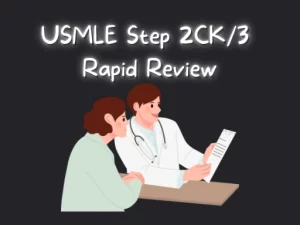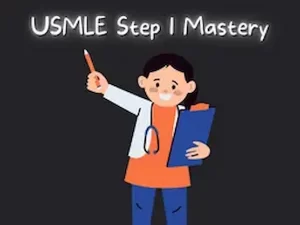Struggling with dense textbooks and endless Qbanks? You’re not alone. Many USMLE aspirants now turn to smarter tools like ChatGPT to simplify their prep. In this guide on how to use ChatGPT to study for USMLE, you’ll discover how to turn AI into your personal tutor. Whether you’re brushing up on biochem or decoding clinical cases, learning how to use ChatGPT for studying could be your secret weapon.
What is ChatGPT?
ChatGPT is a powerful AI tool developed to understand and generate human-like text. Unlike basic search engines, it can hold conversations, explain complex topics step-by-step, and respond like a knowledgeable study partner. This makes it ideal for self-learners who want interactive help instead of just static reading material.
When preparing for an intense exam like the USMLE, students often struggle with clarity, consistency, and the overwhelming amount of material. ChatGPT steps in by breaking down tough topics and making the study experience more engaging and personal. Once you learn how to use ChatGPT for studying, it becomes more than just a chatbot—it turns into your daily tutor.
Why Use ChatGPT for USMLE?
Medical students in India and FMGs often face limited access to high-quality prep resources or mentoring. ChatGPT fills that gap.
Benefits of Using ChatGPT for USMLE:
- Instant Clarification: If you’re stuck on a confusing concept, like the coagulation cascade or the difference between nephrotic and nephritic syndrome, ChatGPT can simplify it in seconds with examples and analogies.
- Customized Study Flow: It adapts to your level. You can ask basic questions or dive into advanced case scenarios based on what you’re preparing for—Step 1, Step 2 CK, or Step 3.
- Time-Efficient Reviews: Instead of re-reading long chapters, ask ChatGPT to summarize key points or list differentials for common symptoms. This saves precious time.
Knowing how to use ChatGPT for studying not only improves understanding but also keeps your preparation on track without feeling overwhelmed.
ChatGPT for Step 1
Step 1 is heavy on foundational sciences, and ChatGPT handles this beautifully.
📘 Best Ways to Use ChatGPT for Step 1:
- Concept Reinforcement: If you’re revising a topic like pharmacokinetics, ask ChatGPT to explain it in layers—from basic to detailed—using practical analogies.
- Mnemonic Generator: Ask ChatGPT to create personalized mnemonics. For example: “Make a mnemonic for cranial nerves with sensory, motor, and both functions.”
- Quiz Yourself: Request 5–10 high-yield questions on any topic, like microbiology or biochemistry, and use the explanations to understand your weak areas.
Example Table: ChatGPT Prompt vs Output for Step 1
| Prompt You Give | What ChatGPT Returns |
|---|---|
| Explain RAS pathway in simple terms | A step-by-step breakdown with analogies |
| Generate USMLE-style question on TB | A case vignette with four answer choices and detailed reasoning |
| Compare gram-positive vs gram-negative | A structured comparison in tabular format |
Once you explore how to use ChatGPT for studying, you’ll realize how efficient this tool is at tackling even your most challenging Step 1 subjects.
ChatGPT for Step 2 CK
Step 2 CK focuses on clinical reasoning and real-world scenarios. ChatGPT helps by simulating cases and guiding your diagnostic thinking.
🔍 How ChatGPT Helps with Step 2 CK:
- Clinical Vignette Practice: You can ask it to generate patient cases, including HPI, investigations, and possible management plans.
- Differential Diagnosis: When given symptoms, ChatGPT can provide a detailed differential diagnosis and explain how to rule each one out.
- Interpretation Help: For complex ECGs, lab reports, or imaging findings, describe the situation and ask ChatGPT to explain what’s happening.
Example Prompt:
“Give me a USMLE-style question on postpartum hemorrhage with explanations.”
This style of preparation builds confidence. Once you begin using chatgpt to study, clinical casework doesn’t feel as scary.
ChatGPT for Step 3
Step 3 includes CCS cases and advanced decision-making. With ChatGPT, you can simulate entire patient scenarios and test your judgment.
💡 How to Use ChatGPT for Step 3:
- Case-Based Learning: Walk through 15-minute cases. For instance: “Take me through managing a diabetic ketoacidosis case.”
- Treatment Flowcharts: Ask ChatGPT to lay out next steps after confirming a diagnosis. Example: “What’s the stepwise treatment for STEMI?”
- Prioritization Practice: Use it to sort urgent vs non-urgent actions in emergencies—key for the Step 3 format.
When you’re focused and know how to use ChatGPT for studying, your Step 3 prep becomes more hands-on and practical.
Study Hacks with ChatGPT
Let’s now dive into chatgpt study hacks that many students have used to simplify their preparation.
🔧 Effective ChatGPT Study Hacks:
- Role-play a Professor: Prompt it to act like a medical professor teaching a topic. You can even say, “Quiz me after explaining.”
- Condensed Notes: Ask ChatGPT to shrink big textbook pages into First-Aid-style bullet summaries you can revise in minutes.
- Flashcard Creator: Provide a topic, and let ChatGPT generate multiple flashcards with Q&A format to load into Anki or review directly.
These chatgpt study hacks are especially helpful if you’re someone who learns better through interaction and repetition.
USMLE Prompt Examples
Here are sample prompts you can copy and use right away:
| Task | Prompt |
|---|---|
| Understand a tough topic | “Explain the mechanism of insulin resistance simply.” |
| Create quiz | “Give me 5 multiple-choice questions on heart murmurs.” |
| Build a study plan | “Make a 7-day study plan for Step 1 biochemistry.” |
| CCS simulation | “Walk me through a CCS case on acute asthma in ER.” |
These examples show that once you understand how to use ChatGPT for studying, you can make your sessions more focused and efficient.
Limitations to Know
While ChatGPT is an excellent supplement, it’s important to be aware of its boundaries.
- Outdated Data: ChatGPT may not include the latest USMLE changes or guidelines. Always cross-check with trusted sources.
- Over-Simplification: It might miss the nuance required in high-stakes exams, especially for advanced topics.
- Not Exam-Specific: It’s not a replacement for USMLE Strike, UWorld, NBME, or NBME self-assessments. Use it to strengthen understanding, not to predict the exam format.
Despite these limitations, when used correctly, ChatGPT for studying can be an incredibly powerful companion.
Ethical Usage Tips
Medical students must use ChatGPT responsibly.
- Use it to learn, not to shortcut your preparation.
- Avoid using it during assessments or in place of required readings or resources.
- Let it enhance your understanding, not become your only source.
By staying ethical, you’ll get the best from chatgpt to study while building solid professional habits.
Conclusion
Preparing for the USMLE doesn’t have to feel overwhelming. With the right tools and strategies, even difficult topics become manageable. Once you master how to use ChatGPT for studying, you’ll unlock a faster, smarter, and more personalized way of learning. Whether you’re using chat gpt for studying full-time or alongside books and Qbanks, this AI-powered method can sharpen your prep and build your confidence. Add it to your daily routine and see the change for yourself.





